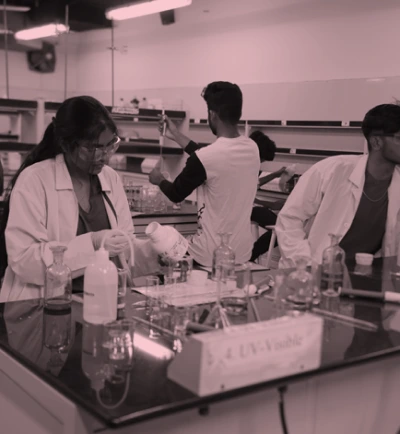
Mrittika Sengupta
Associate Professor
mrittika.sengupta@mahindrauniversity.edu.in
Mrittika Sengupta received her Ph.D from Illinois State University. Her area of specialisation deciphering the molecular mechanism of antimicrobial resistance and biofilm formation in bacterial pathogens such as MRSA and Klebsiella pneumoniae. She did her postdoctoral research at the Miller School of Medicine, University of Miami. Her research was targeted towards the recognition of a biomarker for bacterial biofilms in surgical and non-surgical wounds. She joined the Center for Life Sciences, Mahindra University, as an Associate Professor in May 2023.
Ph.D. (2006-2011)
- Ph.D. in Cell and Molecular Biology, Illinois State University, Illinois, USA: (2006-2011)
M.Sc. (2002-2004)
- M.Sc in Microbiology, Bangalore University, Bangalore: (2002-2004)
B. Sc. (1999-2002)
- B. Sc. in Microbiology, Bangalore University, Bangalore: (1999-2002)
2023- Present
- 2023- Present Associate Professor Center for Life Sciences Mahindra University
2021–2023
- Associate Professor Bennett University Department of Biotechnology: (2021–2023)
2017-2021
- Assistant Professor Bennett University Department of Biotechnology: (2017-2021)
2014-2017
- Department of Biotechnology Research Associate Regional Centre for Biotechnology Faridabad, Haryana: (2014-2017)
2013-2014
- Assistant Professor Uka Tarsadia University, Surat, Gujarat: (2013-2014)
2012-2013
- Postdoctoral Research Associate University of Miami, USA: (2012-2013)
2012
- Adjunct Assistant Professor Illinois Wesleyan University USA: (2012)
2005-2006
- Research intern at Calcutta Medical Research Institute: (2005-2006)
Paper Publications
2023
-
Modi, S. K., Gaur, S., Sengupta, M., & Singh, M. S. (2023). Mechanistic insights into nanoparticle surface-bacterial membrane interactions in overcoming antibiotic resistance. Frontiers in microbiology, 14, 1135579.
https://doi.org/10.3389/fmicb.2023.1135579 - Tripathy, S., Agarkar, T., Talukdar, A., Sengupta, M., Kumar, A., & Ghosh, S. (2023). Evaluation of indirect sequence-specific magneto-extraction-aided LAMP for fluorescence and electrochemical SARS-CoV-2 nucleic acid detection. Talanta, 252, 123809.
2022
- Agarkar, T., Tripathy, S., Chawla, V., Sengupta, M., Ghosh, S., & Kumar, A. (2022). A batch processed titanium-vanadium oxide nanocomposite based solid-state electrochemical sensor for zeptomolar nucleic acid detection. Analytical methods: advancing methods and applications, 14(44), 4495–4513.
- Kumar, S., Kharb, A., Vazirani, A., Chauhan, R. S., Pramanik, G., Sengupta, M., & Ghosh, S. (2022). Nucleic acid extraction from complex biofluid using toothpick-actuated over-the-counter medical-grade cotton. Bioorganic & medicinal chemistry, 73, 117009.
2015
- Vujanac M, Iyer VS, Sengupta M, Ajdic D (2015). Regulation of Streptococcus mutans PTSBio by the transcriptional repressor NigR Mol Oral Microbiol. doi: 10.1111/omi.12093
2012
- Sengupta M, Jain V, Wilkinson BJ and Jayaswal RK(2012). Chromatin Immuno Precipitation Identifies Genes Under Direct VraSR Regulation in Staphylococcus aureus. Can J Microbiol. 58(6):703-8.
2011
- Baker J, Sengupta M, Jayaswal RK and Morrissey JA(2011). The Staphylococcus aureus CsoR regulates both chromosomal and plasmid-encoded copper resistance mechanisms. Environ. Microbiol. Reports. 13(9):2495-507.
- Johnson M, Sengupta M, Purves J, Tarrant E, Williams PH, Cockayne A, Muthaiyan A, Stephenson R, Ledala N, Wilkinson BJ, Jayaswal RK and Morrissey JA (2011). Fur is required for the activation of virulence gene expression through the induction of the sae regulatory system in Staphylococcus aureus. Int J Med Microbiol. 301(1):44-52.
2010
- Ledala N, Sengupta M, Muthaiyan A, Wilkinson BJ and Jayaswal RK(2010). Transcriptomic response of Listeria monocytogenes to iron limitation and fur mutation. Appl Environ Microbiol. 76:406-416.
- Baker J, Sitthisak S, Sengupta M, Johnson M, Jayaswal RK and Morrissey JA (2010). Copper stress induces a global stress responsein Staphylococcus aureus and represses sae and agr expression and biofilm formation. Appl Environ Microbiol. 76:150-160.
Our research interest is understanding the regulatory mechanism of antimicrobial resistance and biofilm formation in bacterial pathogens such as Staphylococcus aureus and Klebsiella pneumoniae. We are also focussing on identifying alternative therapeutic strategies to treat antimicrobial resistant bacterial infections.
Another area of research focus is developing point of care diagnostics to detect infectious diseases.









